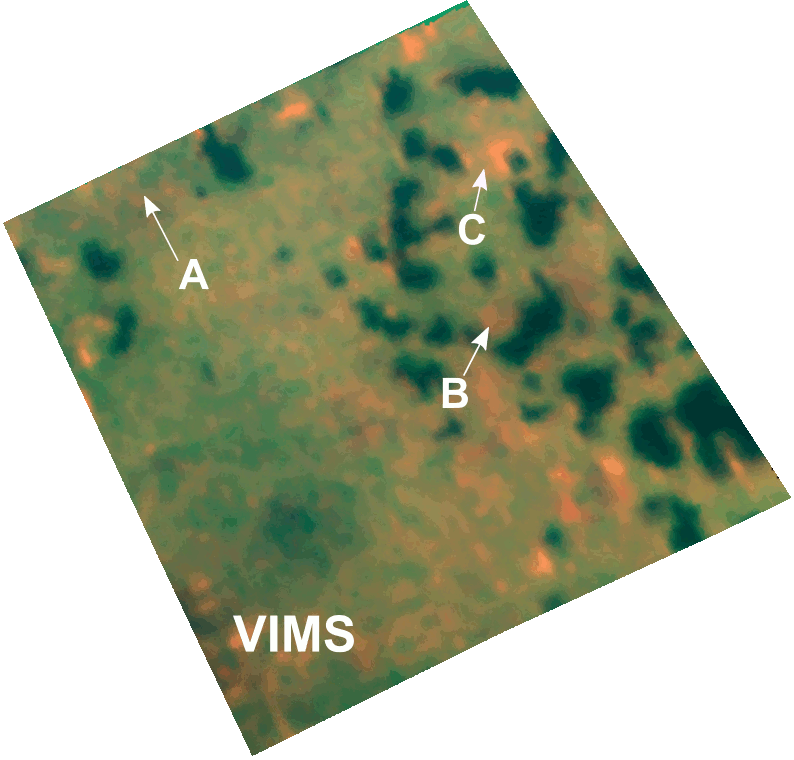April 22, 2019
Disappearing Lakes Offer Clues to Titan's Seasonal Cycles
Dragonfly Would Sample Materials left by Evaporated, Absorbed Liquids

This animation blinks between data from Cassini’s RADAR (NLDSAR) and its Visual and Infrared Mapping Spectrometer (VIMS). The three features (labeled A, B, C) that appear as lakes in radar look like land in VIMS observations made seven years later. Liquid from the lakes may have evaporated and seeped into the surface; scientists suspect seasonal changes – from winter to summer – also played a role in the lakes’ disappearance. Credit: NASA/Johns Hopkins Applied Physics Laboratory/University of Arizona/University of Idaho/ JPL-Caltech/ASI/IPGP/CNRS
The apparent seasonal disappearance of small methane lakes on Titan is giving scientists insight into the complex hydrologic cycle of Saturn's largest moon.
Titan is the only moon in our solar system with a dense atmosphere, which supports an Earth-like cycle of ethane and methane clouds, rain, and liquid that flows into lakes and seas. Examining data from NASA's Cassini mission, a team led by Shannon MacKenzie of the Johns Hopkins Applied Physics Laboratory in Laurel, Maryland, observed three instances where what appeared to be shallow lakes disappeared between winter and summer – a span of about seven years – in the moon’s northern regions.
"It’s the first time we’ve actually seen a lake on Titan’s surface disappear completely,” said MacKenzie, whose results appear in Nature Astronomy. “This tells us that if evaporation is happening as slowly as models predict, then the surface must also be porous enough in these areas for liquid to drain into it for the lakes to disappear."
Understanding the timescales for Titan’s lakes is important for modeling local weather, climate and sediment processing. Titan is the only planetary body in our solar system other than Earth known to have stable liquid on its surface. “These observations give us new insight into the behavior of liquids on Titan’s surface, and how long it takes some of these processes to occur,” MacKenzie said.
MacKenzie added that these processes likely occur at similar rate across that region on Titan, though it’d be harder to observe in the deeper northern lakes. Another Nature Astronomy paper led by Marco Mastrogiuseppe of Caltech in Pasadena, California, reveals that most of the small, liquid lakes in Titan's northern hemisphere are surprisingly deep, perched atop hills and filled mainly with methane – the first confirmation of just how deep some of the moon’s lakes are (more than 300 feet, or 100 meters) and their composition.
The abundant complex organic material accessible on and just below Titan's surface makes it an ideal destination for studying the conditions necessary for the habitability of an extraterrestrial environment and the kinds of chemical interactions that occurred before life developed on Earth. A goal of the proposed Dragonfly mission – a rotorcraft-lander concept vying to become NASA’s next New Frontiers mission – would be to sample areas rich with the materials left by liquids that evaporated or seeped into the surface.

This infrared-color mosaic of data from the Cassini Visual and Infrared Mapping Spectrometer (VIMS) shows the north pole of Titan on Dec. 1, 2013. Lakes and seas appear dark in this color scheme and are distinct from land features like evaporites, the bright orange areas rich with organic deposits the liquids left behind. Credit: NASA/Johns Hopkins Applied Physics Laboratory/ /University of Arizona/University of Idaho
Cassini arrived in the Saturn system in 2004 and ended its mission in 2017 by deliberately diving into Saturn's atmosphere. The spacecraft mapped more than 620,000 square miles (1.6 million square kilometers) of liquid lakes and seas on Titan's surface. It did the work with the radar instrument, which sent out radio waves and collected a return signal (or echo) that gave information about the terrain and the liquid bodies' depth and composition, and with two imaging systems that can penetrate the moon’s thick atmospheric haze.
The Cassini-Huygens mission is a cooperative project of NASA, ESA (European Space Agency) and the Italian Space Agency. NASA's Jet Propulsion Laboratory, a division of Caltech in Pasadena, California, manages the mission for NASA's Science Mission Directorate. JPL designed, developed and assembled the Cassini orbiter. The radar instrument was built by JPL and the Italian Space Agency, working with team members from the U.S. and several European countries.
For more information on Cassini, visit https://solarsystem.nasa.gov/cassini. For more on the proposed Dragonfly mission, visit https://dragonfly.jhuapl.edu


